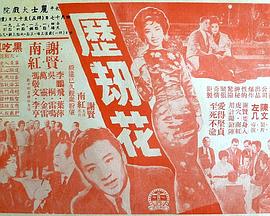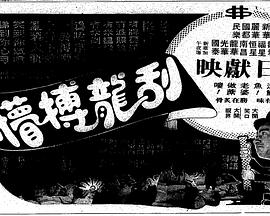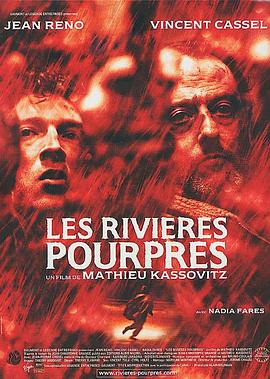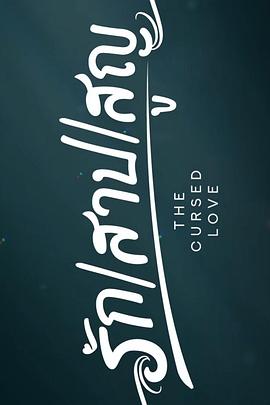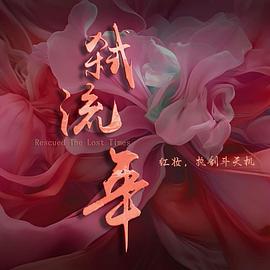正在热播
电影
更多电影1994动作片中国香港
HD
1963剧情片中国香港
HD
1977剧情片中国香港
HD
2023剧情片中国香港,中国大陆
HD
1990剧情片中国香港
HD
2021剧情片中国香港
HD
2017剧情片中国香港,中国大陆
HD
2010动作片香港
HD中字
2020剧情片中国香港,中国大陆
HD
2002剧情片中国香港
HD
2000悬疑片法国
让·雷诺 文森特·卡塞尔 娜迪亚·法尔丝 多米妮克·桑达 让-皮埃尔·卡塞尔 狄迪尔·弗拉蒙 弗朗索瓦·勒凡托 弗朗辛·贝尔热 菲利普·纳翁 文森特·图利 罗兰·拉斐特 Robert Gendreu Christophe Bernard Nicky Naudé Karim Belkhadra Tonio Descanvelle 克里斯朵夫·罗西尼翁
在《暗流》中,一场看似普通的河流污染事件,牵出了一张盘踞小城多年的利益黑网。环保调查员林远与当地记者陈悦因追踪线索意外结盟,却发现污染背后牵扯着政商勾结的致命漩涡。两人在各自领域分头突破:林远冒险潜入
HD
2025恐怖片美国
HD
2025恐怖片美国
HD
2025喜剧片巴西
HD
2023剧情片中国香港
HD
2025喜剧片美国
《巴尔的摩众生相》以美国马里兰州这座充满矛盾与生机的港口城市为舞台,交织呈现了警探、毒贩、教师、政客与码头工人等不同阶层人物的命运轨迹。剧中,一心追查毒品链条的年轻警探与挣扎求生的街头青年意外形成微妙
HD
连续剧
更多连续剧2025国产剧中国大陆
更新至06集
2025日本剧日本
更新至01集
2025国产剧中国大陆
更新至04集
2025日本剧日本
更新至01集
2025台湾剧中国台湾
全09集
2025国产剧中国大陆
更新至04集
2025美国剧美国
《小学风云第五季》将镜头再度聚焦于艾伯特小学的日常战场,这一次教师们不仅要应对标准化考试带来的高压政策,还要化解因新媒体介入校园引发的连锁风波。严苛校长艾娃与理想主义教师珍妮的理念碰撞持续升级,而新入
更新至01集
2025日本剧日本
更新至02集
2025海外剧新加坡
更新至07集
2025国产剧中国大陆
更新至12集
2025泰剧泰国
《诅咒之爱》讲述了一段被命运纠缠的禁忌恋情。年轻考古学者林晚在探索一座古老神庙时,意外解开沉睡百年的诅咒,并与神秘守护者顾夜寒相遇。两人在互相猜疑与试探中,逐渐发现彼此家族背后隐藏的世代恩怨——原来他
更新至01集
2025海外剧英国
全7集
2025日本剧日本
更新至01集
2025国产剧中国大陆
更新至16集
2025美国剧美国
更新至02集
2024海外剧英国
丽贝卡·豪尔 Ollie West 普拉萨纳·瓦纳拉佳 米娅·塔里亚 Niamh McCann 盖尔·兰金 阿马尔·维克德 Lucy Sheen Karen Henthorn 塞缪尔·爱德华-库克 弗兰克·艾殊文 Romy Kelleher Akai Coleman Lucy Chambers Scottee Shreya M. Patel 伊恩·默瑟 基努娜·斯塔梅尔 Delroy Brown Anne Hornby
在《聆听者2024》中,城市深处隐藏着一群天赋异禀的“聆听者”,他们能捕捉他人潜意识中的秘密。年轻的电台主播林音意外觉醒能力后,被迫卷入一场关乎记忆与真相的漩涡。当她发现自己的导师陈默竟与一桩尘封悬案
全5集
综艺
更多综艺2020港台综艺中国台湾
更新至20250701期
更新至20250626期
2016港台综艺中国台湾
更新至20250701期
2011港台综艺中国台湾
更新至20250701期
2025大陆综艺中国大陆
更新至20250816期
2025大陆综艺中国大陆
更新至20250815期
2022大陆综艺大陆
更新至20250629期
2025大陆综艺中国大陆
更新至20250806期
2025大陆综艺大陆
更新至20250926期
2025大陆综艺中国大陆
更新至20251003期
2011大陆综艺中国大陆
更新至20250701期
2018大陆综艺大陆
更新至20250701期
动漫
更多动漫2025日韩动漫日本
更新至01集
2025日韩动漫日本
更新至02集
2025日韩动漫日本
更新至01集
2025日韩动漫日本
更新至01集
2025日韩动漫日本
更新至01集
2025日韩动漫日本
更新至01集
2025日韩动漫日本
更新至01集
2025国产动漫中国大陆
更新至04集
2025国产动漫中国大陆
更新至04集
2025国产动漫中国大陆
更新至03集
2024国产动漫中国大陆
更新至87集
2025国产动漫中国大陆
更新至02集
2025日韩动漫日本
更新至01集
2019国产动漫中国大陆
更新至609集
2020国产动漫中国大陆
更新至504集
2025国产动漫大陆
改写后的版本:当黑暗纪元突然降临人间,命运给了陈木一次重生的机会。这位带着前世记忆归来的男人,手中掌握着令人窒息的万亿诡币财富。在旁人还在为几张冥币争得头破血流时,陈木早已以天使投资人的身份,将一
更新至54集
短剧
更多短剧2025现代都市中国大陆
全集
2025年代穿越中国大陆
全集
2025女频恋爱中国大陆
当嗅觉天才少女苏晓晓被迫与身价千亿却罹患嗅觉障碍的顾氏总裁联姻,一场关于气味的战争在婚房里悄然爆发。她调制的栀子前调撞上他珍藏的雪松木香,香水实验室与总裁书房在别墅内划出楚河汉界。直到某夜顾总将人抵在
全集
2025现代都市中国大陆
全集
2025年代穿越中国大陆
全集
2025年代穿越中国大陆
当世界被丧尸狂潮撕裂,五岁的小诺在避难所里觉醒了跨越千里的心灵感应。通过这份神秘力量,他窥见了失踪母亲苏璃在废墟中浴血奋战的画面——她竟手握能改写末世法则的基因秘钥!一边是萌娃在人类基地用奶音指挥战局
全集
2025反转爽剧中国大陆
《签到成圣发现老婆竟是魔教女帝》讲述了一名穿越者凭借每日签到系统轻松踏上武道巅峰,却在功成名就时惊觉枕边温柔贤淑的妻子,竟是江湖中令人闻风丧胆的魔教女帝。他习武不为争霸只为守护小家安宁,而她执掌杀伐却
全集
2025年代穿越中国大陆
在《签到万年开局就被妹妹直播曝光》中,隐居万年的绝世强者本想低调生活,却因妹妹无意间开启的直播彻底打乱了计划。当镜头对准他随手泡的一壶茶,竟引发天地异象;一句无心指点,便让当世宗师顿悟突破。全世界的目
全集
2025现代都市中国大陆
全集
2025女频恋爱中国大陆
全集
2025古装仙侠中国大陆
当花轿临门喜乐震天,新郎却当众掷下一纸休书,所有人都以为苏家千金将沦为全城笑柄。岂料三日后,权倾朝野的摄政王竟携十里红妆踏碎流言,鎏金聘礼从宫门蜿蜒至苏府阶前。原来那场屈辱的休弃,是他为护心上人周全的
全集
2025古装仙侠中国大陆
全集
2025女频恋爱中国大陆
全集
2025女频恋爱中国大陆
全集
2025年代穿越中国大陆
《重生后,开局给校花一香蕉皮》讲述了一个充满奇幻反转的校园故事。男主角林远意外重生回到高中时代,决心弥补前世遗憾。然而命运却与他开了个玩笑——刚睁眼就不慎将香蕉皮甩到了校花苏雨晴脚下,导致她当众滑倒。
全集
最新影片
选择类型
全部电影连续剧综艺动漫短剧
1994动作片中国香港
HD
1963剧情片中国香港
HD
1977剧情片中国香港
HD
2023剧情片中国香港,中国大陆
HD
1990剧情片中国香港
HD
2021剧情片中国香港
HD
2017剧情片中国香港,中国大陆
HD
2010动作片香港
HD中字
2020剧情片中国香港,中国大陆
HD
2002剧情片中国香港
HD
2025国产剧中国大陆
更新至06集
2025日本剧日本
更新至01集
2025国产剧中国大陆
更新至04集
2025现代都市中国大陆
全集
2025年代穿越中国大陆
全集
2025女频恋爱中国大陆
当嗅觉天才少女苏晓晓被迫与身价千亿却罹患嗅觉障碍的顾氏总裁联姻,一场关于气味的战争在婚房里悄然爆发。她调制的栀子前调撞上他珍藏的雪松木香,香水实验室与总裁书房在别墅内划出楚河汉界。直到某夜顾总将人抵在
全集
1994动作片中国香港
HD
1963剧情片中国香港
HD
1977剧情片中国香港
HD
2023剧情片中国香港,中国大陆
HD
1990剧情片中国香港
HD
2021剧情片中国香港
HD
2017剧情片中国香港,中国大陆
HD
2010动作片香港
HD中字
2020剧情片中国香港,中国大陆
HD
2002剧情片中国香港
HD
2000悬疑片法国
让·雷诺 文森特·卡塞尔 娜迪亚·法尔丝 多米妮克·桑达 让-皮埃尔·卡塞尔 狄迪尔·弗拉蒙 弗朗索瓦·勒凡托 弗朗辛·贝尔热 菲利普·纳翁 文森特·图利 罗兰·拉斐特 Robert Gendreu Christophe Bernard Nicky Naudé Karim Belkhadra Tonio Descanvelle 克里斯朵夫·罗西尼翁
在《暗流》中,一场看似普通的河流污染事件,牵出了一张盘踞小城多年的利益黑网。环保调查员林远与当地记者陈悦因追踪线索意外结盟,却发现污染背后牵扯着政商勾结的致命漩涡。两人在各自领域分头突破:林远冒险潜入
HD
2025恐怖片美国
HD
2025恐怖片美国
HD
2025喜剧片巴西
HD
2023剧情片中国香港
HD
2025喜剧片美国
《巴尔的摩众生相》以美国马里兰州这座充满矛盾与生机的港口城市为舞台,交织呈现了警探、毒贩、教师、政客与码头工人等不同阶层人物的命运轨迹。剧中,一心追查毒品链条的年轻警探与挣扎求生的街头青年意外形成微妙
HD
2025国产剧中国大陆
更新至06集
2025日本剧日本
更新至01集
2025国产剧中国大陆
更新至04集
2025日本剧日本
更新至01集
2025台湾剧中国台湾
全09集
2025国产剧中国大陆
更新至04集
2025美国剧美国
《小学风云第五季》将镜头再度聚焦于艾伯特小学的日常战场,这一次教师们不仅要应对标准化考试带来的高压政策,还要化解因新媒体介入校园引发的连锁风波。严苛校长艾娃与理想主义教师珍妮的理念碰撞持续升级,而新入
更新至01集
2025日本剧日本
更新至02集
2025海外剧新加坡
更新至07集
2025国产剧中国大陆
更新至12集
2025泰剧泰国
《诅咒之爱》讲述了一段被命运纠缠的禁忌恋情。年轻考古学者林晚在探索一座古老神庙时,意外解开沉睡百年的诅咒,并与神秘守护者顾夜寒相遇。两人在互相猜疑与试探中,逐渐发现彼此家族背后隐藏的世代恩怨——原来他
更新至01集
2025海外剧英国
全7集
2025日本剧日本
更新至01集
2025国产剧中国大陆
更新至16集
2025美国剧美国
更新至02集
2024海外剧英国
丽贝卡·豪尔 Ollie West 普拉萨纳·瓦纳拉佳 米娅·塔里亚 Niamh McCann 盖尔·兰金 阿马尔·维克德 Lucy Sheen Karen Henthorn 塞缪尔·爱德华-库克 弗兰克·艾殊文 Romy Kelleher Akai Coleman Lucy Chambers Scottee Shreya M. Patel 伊恩·默瑟 基努娜·斯塔梅尔 Delroy Brown Anne Hornby
在《聆听者2024》中,城市深处隐藏着一群天赋异禀的“聆听者”,他们能捕捉他人潜意识中的秘密。年轻的电台主播林音意外觉醒能力后,被迫卷入一场关乎记忆与真相的漩涡。当她发现自己的导师陈默竟与一桩尘封悬案
全5集
2020港台综艺中国台湾
更新至20250701期
更新至20250626期
2016港台综艺中国台湾
更新至20250701期
2011港台综艺中国台湾
更新至20250701期
2025大陆综艺中国大陆
更新至20250816期
2025大陆综艺中国大陆
更新至20250815期
2022大陆综艺大陆
更新至20250629期
2025大陆综艺中国大陆
更新至20250806期
2025大陆综艺大陆
更新至20250926期
2025大陆综艺中国大陆
更新至20251003期
2011大陆综艺中国大陆
更新至20250701期
2018大陆综艺大陆
更新至20250701期
2025日韩动漫日本
更新至01集
2025日韩动漫日本
更新至02集
2025日韩动漫日本
更新至01集
2025日韩动漫日本
更新至01集
2025日韩动漫日本
更新至01集
2025日韩动漫日本
更新至01集
2025日韩动漫日本
更新至01集
2025国产动漫中国大陆
更新至04集
2025国产动漫中国大陆
更新至04集
2025国产动漫中国大陆
更新至03集
2024国产动漫中国大陆
更新至87集
2025国产动漫中国大陆
更新至02集
2025日韩动漫日本
更新至01集
2019国产动漫中国大陆
更新至609集
2020国产动漫中国大陆
更新至504集
2025国产动漫大陆
改写后的版本:当黑暗纪元突然降临人间,命运给了陈木一次重生的机会。这位带着前世记忆归来的男人,手中掌握着令人窒息的万亿诡币财富。在旁人还在为几张冥币争得头破血流时,陈木早已以天使投资人的身份,将一
更新至54集
2025现代都市中国大陆
全集
2025年代穿越中国大陆
全集
2025女频恋爱中国大陆
当嗅觉天才少女苏晓晓被迫与身价千亿却罹患嗅觉障碍的顾氏总裁联姻,一场关于气味的战争在婚房里悄然爆发。她调制的栀子前调撞上他珍藏的雪松木香,香水实验室与总裁书房在别墅内划出楚河汉界。直到某夜顾总将人抵在
全集
2025现代都市中国大陆
全集
2025年代穿越中国大陆
全集
2025年代穿越中国大陆
当世界被丧尸狂潮撕裂,五岁的小诺在避难所里觉醒了跨越千里的心灵感应。通过这份神秘力量,他窥见了失踪母亲苏璃在废墟中浴血奋战的画面——她竟手握能改写末世法则的基因秘钥!一边是萌娃在人类基地用奶音指挥战局
全集
2025反转爽剧中国大陆
《签到成圣发现老婆竟是魔教女帝》讲述了一名穿越者凭借每日签到系统轻松踏上武道巅峰,却在功成名就时惊觉枕边温柔贤淑的妻子,竟是江湖中令人闻风丧胆的魔教女帝。他习武不为争霸只为守护小家安宁,而她执掌杀伐却
全集
2025年代穿越中国大陆
在《签到万年开局就被妹妹直播曝光》中,隐居万年的绝世强者本想低调生活,却因妹妹无意间开启的直播彻底打乱了计划。当镜头对准他随手泡的一壶茶,竟引发天地异象;一句无心指点,便让当世宗师顿悟突破。全世界的目
全集
2025现代都市中国大陆
全集
2025女频恋爱中国大陆
全集
2025古装仙侠中国大陆
当花轿临门喜乐震天,新郎却当众掷下一纸休书,所有人都以为苏家千金将沦为全城笑柄。岂料三日后,权倾朝野的摄政王竟携十里红妆踏碎流言,鎏金聘礼从宫门蜿蜒至苏府阶前。原来那场屈辱的休弃,是他为护心上人周全的
全集
2025古装仙侠中国大陆
全集
2025女频恋爱中国大陆
全集
2025女频恋爱中国大陆
全集
2025年代穿越中国大陆
《重生后,开局给校花一香蕉皮》讲述了一个充满奇幻反转的校园故事。男主角林远意外重生回到高中时代,决心弥补前世遗憾。然而命运却与他开了个玩笑——刚睁眼就不慎将香蕉皮甩到了校花苏雨晴脚下,导致她当众滑倒。
全集


